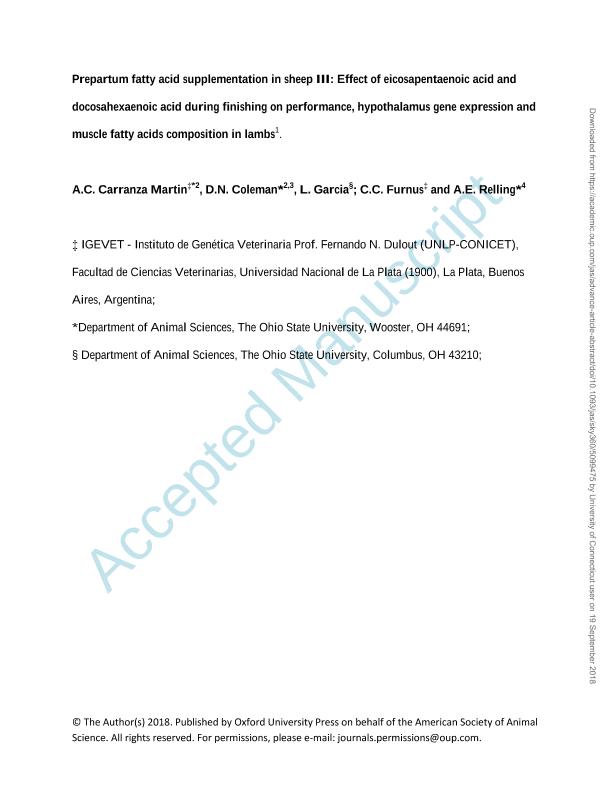Mostrar el registro sencillo del ítem
dc.contributor.author
Carranza Martin, Ana Cristina

dc.contributor.author
Coleman, Danielle Nicole
dc.contributor.author
Garcia, Lyda Guadalupe
dc.contributor.author
Furnus, Cecilia Cristina

dc.contributor.author
Relling, Alejandro Enrique

dc.date.available
2019-10-22T17:08:58Z
dc.date.issued
2018-12
dc.identifier.citation
Carranza Martin, Ana Cristina; Coleman, Danielle Nicole; Garcia, Lyda Guadalupe; Furnus, Cecilia Cristina; Relling, Alejandro Enrique; Prepartum fatty acid supplementation in sheep. III. Effect of eicosapentaenoic acid and docosahexaenoic acid during finishing on performance, hypothalamus gene expression, and muscle fatty acids composition in lambs; American Society of Animal Science; Journal of Animal Science; 96; 12; 12-2018; 5300-5310
dc.identifier.issn
0021-8812
dc.identifier.uri
http://hdl.handle.net/11336/86891
dc.description.abstract
The objectives of this study were to evaluate the effect of feeding an enriched diet with eicosapentaenoic acid (EPA) and docosahexaenoic acid (DHA) to finishing lambs born from ewes supplemented either with or without EPA and DHA during late gestation on productive performance, muscle fatty acid (FA), and hypothalamus mRNA concentration of metabolic genes and hormone receptors. Lambs born from dams fed during the last 50 d of gestation either with a control diet containing 0.39% Ca salts of palmitic fatty acid distillate (C) or Ca salts enriched with EPA and DHA (PFA) were used. After weaning lambs (n = 70) were blocked by weight (BW) and used in a 2 × 2 factorial into 2 finishing diets containing 1.5% of C or PFA. The 2 factors were the ewe diet and the finishing diet. Lambs (37.9 ± 0.4 kg) were weighed and blood sampled for glucose and NEFA measurements at days 1, 14, 28, and 42. Dry matter intake (DMI) was measured daily. At day 43, 14 females and 14 males were slaughtered, and hot carcass weight, body wall thickness, rib eye area, and FA composition of Longissumus thoracis muscle were evaluated. Female hypothalamuses were obtained and mRNA concentration of hormone receptors, neuropeptides, and their receptors was measured. Lambs born from PFA dams were heavier (P < 0.01). There was a time × finishing diet interaction for BW (P = 0.03), and lambs fed C had a greater BW. Lambs fed C had an increase in DMI (P < 0.01). There were no significant differences in plasma glucose and NEFA concentration (P > 0.1). Lambs born from PFA dams had a greater concentration of C22:0 (P < 0.03). Lambs fed C had higher concentrations of C18:1c15 (P < 0.01), C17:0 (P < 0.09), C18:0 (P < 0.09), and n6/n3 (P < 0.01). Lambs fed PFA had greater concentration (P < 0.05) of C16:1, C22:1, C20:5, C22:5, C22:6, total n3 FA, and total EPA and DHA. There was a significant dam × finishing diet interaction (P ≤ 0.08) on mRNA concentration for MCR3, CCK-R, Cort-R, and CART. Lambs, which had the same treatment as their dams, showed lower overall mRNA concentration than those with different treatments between them and their dams. Lambs born from PFA ewes had lower concentration of MCR4 mRNA (P = 0.09) than C. Agouti-related peptides mRNA concentration was lower in lambs fed PFA (P = 0.06) than C. In conclusion, changes on lamb performance, muscle fatty acid composition, and metabolic neuropeptides depend not only on the lamb diet, but also on the dam diet during late gestation.
dc.format
application/pdf
dc.language.iso
eng
dc.publisher
American Society of Animal Science

dc.rights
info:eu-repo/semantics/openAccess
dc.rights.uri
https://creativecommons.org/licenses/by-nc-sa/2.5/ar/
dc.subject
FETAL PROGRAMMING
dc.subject
GESTATION
dc.subject
OMEGA-3 FATTY ACIDS
dc.subject.classification
Otras Ciencias Veterinarias

dc.subject.classification
Ciencias Veterinarias

dc.subject.classification
CIENCIAS AGRÍCOLAS

dc.title
Prepartum fatty acid supplementation in sheep. III. Effect of eicosapentaenoic acid and docosahexaenoic acid during finishing on performance, hypothalamus gene expression, and muscle fatty acids composition in lambs
dc.type
info:eu-repo/semantics/article
dc.type
info:ar-repo/semantics/artículo
dc.type
info:eu-repo/semantics/publishedVersion
dc.date.updated
2019-10-17T15:46:13Z
dc.journal.volume
96
dc.journal.number
12
dc.journal.pagination
5300-5310
dc.journal.pais
Estados Unidos

dc.journal.ciudad
Urbana
dc.description.fil
Fil: Carranza Martin, Ana Cristina. Consejo Nacional de Investigaciones Científicas y Técnicas. Centro Científico Tecnológico CONICET- La Plata. Instituto de Genética Veterinaria "Ing. Fernando Noel Dulout". Universidad Nacional de La Plata. Facultad de Ciencias Veterinarias. Instituto de Genética Veterinaria; Argentina
dc.description.fil
Fil: Coleman, Danielle Nicole. Ohio State University; Estados Unidos
dc.description.fil
Fil: Garcia, Lyda Guadalupe. Ohio State University; Estados Unidos
dc.description.fil
Fil: Furnus, Cecilia Cristina. Consejo Nacional de Investigaciones Científicas y Técnicas. Centro Científico Tecnológico CONICET- La Plata. Instituto de Genética Veterinaria "Ing. Fernando Noel Dulout". Universidad Nacional de La Plata. Facultad de Ciencias Veterinarias. Instituto de Genética Veterinaria; Argentina
dc.description.fil
Fil: Relling, Alejandro Enrique. Ohio State University; Estados Unidos
dc.journal.title
Journal of Animal Science

dc.relation.alternativeid
info:eu-repo/semantics/altIdentifier/doi/http://dx.doi.org/10.1093/jas/sky360
dc.relation.alternativeid
info:eu-repo/semantics/altIdentifier/url/https://academic.oup.com/jas/article/96/12/5300/5099475
Archivos asociados
